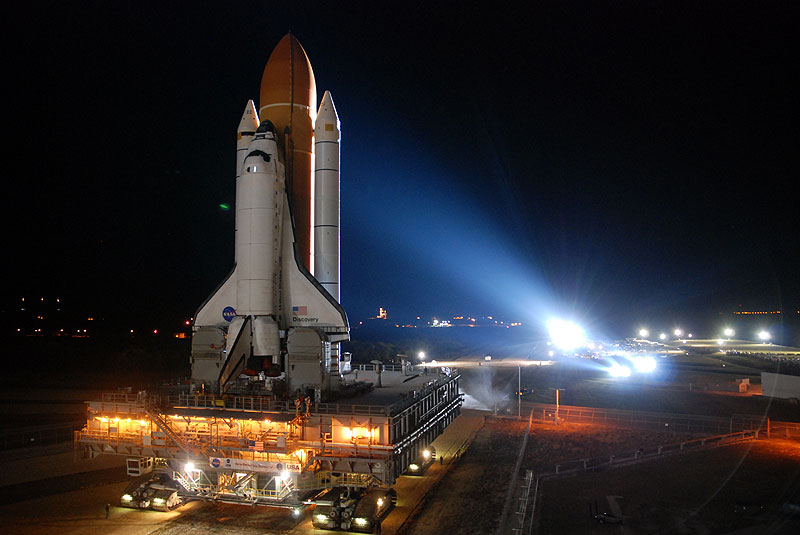NASA Contractor Bids to Continue Flying Space Shuttle

CAPE CANAVERAL, Fla. — United Space Alliance is preparing a long shot bid to continue flying the shuttle as a commercial service after NASA completes its last three planned missions this year.
Starting as soon as 2013, after construction of a new external tank, the lead operator of NASA's shuttle fleet proposes to fly twice a year with Atlantis and Endeavour at a cost of less than $1.5 billion a year.
If supported, the plan would reduce an anticipated gap of at least four years between launch of the last shuttle mission this year and availability of new privately run crew taxis, a period during which astronauts will depend on Russian spacecraft to reach the International Space Station.
"We thought this was a good option to be put on the table to be evaluated with all the other commercial options, since it's a vehicle that has really proven itself," said Mark Nappi, head of Houston-based USA's Florida operations. "It is safe. We have a lot of history, we understand how to operate it."
To avoid giving the company's employees false hope, however, Nappi has told them the proposal is "very much a long shot."
USA initially has proposed a six-month study of the commercial shuttle option, something Nappi noted has been studied a handful of times since the '90s.
The company asked NASA to help fund the study under a program set up to speed the development of new rockets and spacecraft able to carry people. Winners of the program's $200 million second round of funding are expected to be announced next month.
Get the Space.com Newsletter
Breaking space news, the latest updates on rocket launches, skywatching events and more!
NASA has refused to comment on any of the companies' bids.
Nappi said it was too soon to estimate how many local jobs USA's Commercial Shuttle Transportation Service could produce. The company's local workforce, 6,000 strong two years ago, is expected to drop from 3,900 now down to about 1,000 after the last mission.
"We have a lot of work to do to even decide whether or not a business case exists," he said. "We have a lot of work to do to see if NASA is even interested, and politically, that's just a big question mark that none of us could ever predict. It is probably still a low probability."
The nearly $1.5 billion program proposed by USA is less than half the $3.1 billion budgeted for the shuttle in 2010. For about the same amount, NASA has contracted with SpaceX to fly 12 cargo flights to the station with its much smaller Dragon spacecraft, and SpaceX said it expects four crewed flights a year to cost $560 million.
With tight budgets anticipated for years, continued spending on the shuttle would divert money from development of new commercial crew taxis and a heavy-lift rocket and capsule for exploration missions.
Some, including NASA's independent safety advisory panel and Columbia accident investigators, have called for the shuttle to be retired for safety reasons.
But one space expert said USA's idea merits consideration as a way to ensure that NASA's top priority, the space station, continues to run smoothly even if commercial vehicles run into problems with planned deliveries of critical cargo.
"You need to have backup options, and this is a potentially expensive but very capable backup option that should be considered," said Scott Pace, director of the Space Policy Institute at George Washington University.
USA envisions shuttle flights continuing until at least 2017, or whenever NASA is ready to transition to different commercial vehicles.
All three orbiters would be kept, including Discovery for spare parts, rather than being shipped to museums for public display as currently planned by NASA.
Nappi said many details need to be studied further, including the terms under which NASA would allow USA to continue operating the nation's shuttle fleet.
He said workforce consolidation and more efficient vehicle processing could reduce operating costs without compromising safety.
More savings would be achieved if NASA chooses a shuttle-derived heavy-lift rocket design that uses solid rocket boosters, shuttle main engines or a booster based on the external tank, along with some of the same ground equipment.
And a commercial shuttle might fly space tourists or non-NASA payloads that would offset the cost to the government. It could even test systems being developed for other commercial spacecraft.
Nappi said he wasn't sure if USA would continue to pursue the business if NASA doesn't fund the commercial shuttle study next month.
"It really depends on the interest of customers, NASA and the other potential customers," he said. "If there's an interest there, we'll continue to work on it. If there's no interest, we're not going to waste our money."
Contact Dean at 321-639-3644 or jdean@floridatoday.com
Join our Space Forums to keep talking space on the latest missions, night sky and more! And if you have a news tip, correction or comment, let us know at: community@space.com.
James Dean is a former space reporter at Florida Today, covering Florida's Space Coast through 2019. His writing for Space.com, from 2008 to 2011, mainly concerned NASA shuttle launches, but more recently at Florida Today he has covered SpaceX, NASA's Delta IV rocket, and the Israeli moon lander Beresheet.

